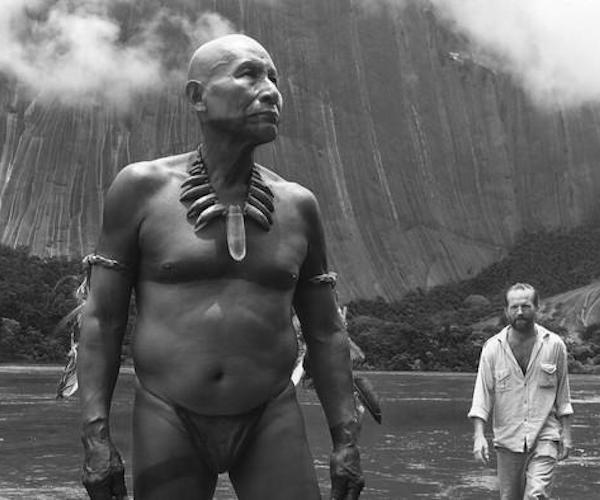Film Review: “Embrace of the Serpent” — A Spellbinding Dream of Nature’s Power
Embrace of the Serpent presents a world where nature and dreams provide the most satisfying answers; logic and science are besides the elemental point.
Embrace of the Serpent, directed by Ciro Guerra. At Kendall Square Cinema, Cambridge, MA

A scene from “Embrace of the Serpent.”
By Tim Jackson
Embrace of the Serpent, Colombia’s 2016 Academy Award entry for Best Foreign film is a fascinating hallucination, compellingly real and deeply mystical. Crosscutting stories set decades apart, the narrative revolves around two scientists exploring the Amazon River in search of rare and exotic plants. Their guide, Karamakate is played by Nilbio Torres (as the younger) and Antonio Bolivar (as the older). Clad only in wrapped loincloths, Torres and Bolivar exude an unshakable iconic presence, concrete projections of the forest primeval. Karamakate is a shaman, a healer, a philosopher and, he believes, the last survivor of his tribe.
This is world where nature and dreams provide the most satisfying answers; logic and science are besides the elemental point. The scientists (fictional versions of Theodor Koch-Grünberg and Richard Evans Schultes) carry sketchbooks, cameras, navigational tools, and other supplies. They collect and archive; their prize catch is the rare and psychedelic Yakruna plant. This concern with material things and obsessive record keeping is time-wasting nonsense to Karamakate, who finds the truth in dreams, visions, and abandoning oneself to the ancient rhythms of nature and the sky. “Why do you whites like your stuff so much?” asks their mystified guide.
This archetypal world, indifferent to rational sense, is closer to the consciousness raising of the Tales of Carlos Castaneda than the primal shock of Werner Herzog’s Aguirre. (With the exception of one stunning color sequence, the film is photographed entirely in rich black and white.) Writer and director Ciro Guerra in interested in creating a spellbinding metaphysical journey: time and location are nebulous, the narrative touched by divine madness. There are unexplained natural cures and rituals; the assertion is that a profound contact with the world is received through nature and from unworldly visions. Hostile positions are confronted. There’s a scene featuring a Catholic priest with a servile flock of converts. “No pagan languages,” he bellows, denying them their traditional language. Corporal punishment is common, especially for the children. Another striking scene, featuring a fully mad Colonel Kurtz / Jim Jones type figure and his zombified followers, is about unhinged messianic insanity. Meanwhile, the threat of outright extinction to the ancient ways is posed by the white rubber merchants who savage the land.
Koch-Grünberg and Schultes were important figures in ethnology. Schultes is considered the father of ethnobotany. The German Koch-Grünberg, guided by decade old maps, explored the region from 1903-1905, and again in 1911. He kept scientific journals on ethnography, botany, meteorology, on geography, geology, and insects. He also made studies of the myths and legends of the Pemón Indians. When we meet him in the film he is on his last legs, suffering from malaria. He meets Karamakate and convinces him to find a cure for the scientist’s disease. Despite his request, Koch-Grünberg remains stubbornly Western in his thinking, never quite able to abandon himself to the natural world.
The real life Schultes attended Harvard University in the ’30s where he wrote an undergraduate paper on the mind-altering properties of peyote. He studied the crucial relationship between native cultures and their use of plants. His research on hallucinogenic and medicinal plants (one of his many students was Andrew Weil) influenced William Burroughs, Aldous Huxley, and the psychedelic movements of the ’60s. As a scientist he documented 2,000 medicinal plants, and gathered some 24,000 specimens. His best known work is Plants of the Gods (1979), written with Albert Hofmann, the chemist who synthesized LSD.
As portrayed in the film, Schultes is at first resistant to indigenous ways of understanding the universe, but he slowly casts aside his skepticism. In his book Plants of the Gods, Schultes stands in respectful silence before the mysteries of the mind: “The psychic change and unusual states of consciousness induced by hallucinogens are so far removed from similarity with ordinary life that it is scarcely possible to describe them in the language of daily living.”
Embrace of the Serpent calls for respect for Karamakate and other vanishing people who understand the efficacy of mystical belief. Respect for cultural traditions and history need not be cast aside for the sake of profit or science. The deepest connections to our world, the film suggests, are rooted in nature’s rhythms and a respect for the past. Karamakate’s advice to Schultes holds true: “Listen to your ancestors. The world speaks.”
Tim Jackson was an assistant professor of Digital Film and Video for 20 years. His music career in Boston began in the 1970s and includes some 20 groups, recordings, national and international tours, and contributions to film soundtracks. He studied theater and English as an undergraduate, and has also has worked helter skelter as an actor and member of SAG and AFTRA since the 1980s. He has directed three feature documentaries: Chaos and Order: Making American Theater about the American Repertory Theater; Radical Jesters, which profiles the practices of 11 interventionist artists and agit-prop performance groups; When Things Go Wrong: The Robin Lane Story, and the short film The American Gurner. He is a member of the Boston Society of Film Critics. You can read more of his work on his blog.
